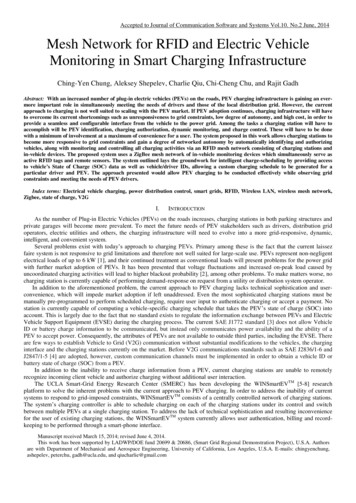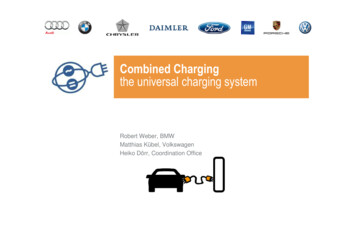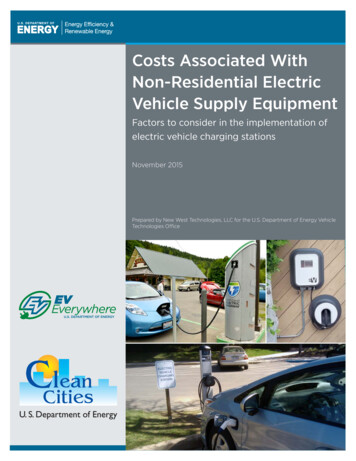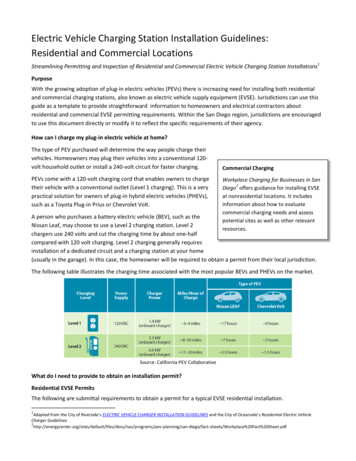
Transcription
Electric Vehicle Charging inResidential and Non-ResidentialBuildingsJuly 2019
The Department for Transport has actively considered the needs of blind and partiallysighted people in accessing this document. The text will be made available in full on theDepartment’s website. The text may be freely downloaded and translated by individuals ororganisations for conversion into other accessible formats. If you have other needs in thisregard please contact the Department.Department for TransportGreat Minster House33 Horseferry RoadLondon SW1P 4DRTelephone 0300 330 3000Website www.gov.uk/dftGeneral enquiries: https://forms.dft.gov.uk Crown copyright 2018Copyright in the typographical arrangement rests with the Crown.You may re-use this information (not including logos or third-party material) free of chargein any format or medium, under the terms of the Open Government Licence. To view thislicence, visit ment-licence/version/3/or write to the Information Policy Team, The National Archives, Kew, London TW9 4DU, ore-mail: psi@nationalarchives.gsi.gov.ukWhere we have identified any third-party copyright information you will need to obtainpermission from the copyright holders concerned.
ContentsMinisterial Foreword5Executive summary6Building Regulations changes7Requirements for existing buildings8Data and analysis9How to respond10Privacy Information Notice: Confidentiality and data protection11Freedom of Information111. Introduction12Background and scope of the consultation12Future Homes Standard14Technological Scope14The Building Regulations15Territorial extent and devolved administrations15Timings and implementation152. The installation of electric vehicle chargepoints in buildings17Background on electric vehicle charging17Building types18Chargepoint installation in buildings193. Building Regulations changes: New residential buildings and residentialbuildings undergoing major renovation20Proposed requirement21Infrastructure requirement21Buildings within scope of the changes23Material Change of Use24Major Renovations254. Building Regulations changes: New non-residential buildings and nonresidential buildings undergoing major renovation275. Existing non-residential buildings296. Technical specifications for Building Regulation requirements313
Definitions31Chargepoint Power32Chargepoint Mode32Chargepoint connector33Location and accessibility requirements33Safety requirements34Scope347. Exemptions36Exemption options36Lead-in times for new residential and non-residential buildings37Further exemptions for new residential buildings and residential buildingsundergoing major renovation37Further exemptions for new non-residential buildings and non-residentialbuildings undergoing major renovations40Exemptions for existing non-residential buildings408. Evidence and Analysis42New Residential Buildings42New Non-Residential Buildings43What will happen next45Annex A: Full list of consultation questions46Annex B: Consultation principles504
Ministerial ForewordLast year the government published the Road to Zero strategy, which set out acomprehensive package of support to reach our mission for all new cars and vans tobe effectively zero emission by 2040.Since then, the government has worked to implement this strategy to improve the airwe breathe, help ensure we meet our future carbon budgets and build a new marketfor zero emission vehicle technologies in the UK. Progress has been made, butfurther work is needed to drive electric vehicle uptake, deliver our Industrial Strategymission and rise to the new challenge of net zero greenhouse gas emissions by2050.This consultation is central to delivering these aims. This consultation proposesregulatory changes which will results in thousands more chargepoints across the UK,in homes and at key destinations, like new office blocks and supermarkets. Thepolicies outlined will ensure new buildings are ready for the future. They representthe most ambitious regulatory package in the world for electric vehicle infrastructureand will help ensure the UK has one of the best electric vehicle infrastructurenetworks in the world.RT HON CHRIS GRAYLING MPRT HON GREG CLARK MP5
Executive summaryIntroduction1Last year the government published the Road to Zero strategy, which set out acomprehensive package of support to reach our mission for all new cars and vans tobe effectively zero emission by 2040. This transition is vital if we are to clean up theair we breathe and shift to an economy with net zero greenhouse gas emissions by2050.2Charging cars at home overnight using a dedicated chargepoint is generally cheaperand more convenient for consumers and ensures that EVs can play a full part in ourfuture smart and flexible energy system. For these reasons, today the majority(around 80%) of all electric car charging happens at home and we expect the hometo be central to the future charging ecosystem.3That is why in the Road to Zero strategy, the government set out its intention for allnew homes to be electric vehicle (EV) ready and committed to consult onrequirements for every new home to have a chargepoint, where appropriate.4This consultation sets out how we propose to deliver this commitment. It also outlineshow we propose transposing the requirements from the EU Energy Performance ofBuildings Directive (EPBD) to also set minimum requirements for electric vehiclecharging infrastructure in new and existing non-residential buildings.5Alongside this consultation document, we are publishing: a draft Approved Document for the proposed changes to the BuildingRegulations (see Annex C). an impact assessment covering the proposed requirements for new residentialbuildings (Annex D). an impact assessment covering the proposed requirements for new andexisting non-residential buildings (Annex E).6Through the consultation, we are seeking views on our policy position and whetherthe technical specifications are clear and meet the intended policy aims. We wouldalso like to invite further information on costs and benefits associated with the policy.This consultation applies to England only. The Building Regulations and wider EPBDtransposition are a devolved matter.6
Summary of proposed policy positionsPolicy position: Residential BuildingsThe government proposes every new residential building with an associated carparking space to have a chargepoint. We propose this requirement applies tobuildings undergoing a material change of use to create a dwelling.The government proposes requiring every residential building undergoing majorrenovation with more than 10 car parking spaces to have cable routes for electricvehicle chargepoints in every car parking space.Policy position: New Non-Residential BuildingsThe government proposes every new non-residential building and every nonresidential building undergoing a major renovation with more than 10 car parkingspaces to have one chargepoint and cable routes for an electric vehiclechargepoint for one in five spaces.Policy position: Existing Non-Residential BuildingsThe government proposes a requirement of at least one chargepoint in existingnon-residential buildings with more than 20 car parking spaces, applicable from2025.Building Regulations changes7This consultation proposes the creation of a new part to the English BuildingRegulations requiring electric vehicle charging infrastructure in new buildings andbuildings undergoing material change of use and major renovation.Residential buildings8For residential buildings, the Road to Zero strategy set out that the governmentwants every new home to have a chargepoint, where appropriate. This includesnewly built homes and homes created through a material change of use of anexisting building. We propose a requirement of a chargepoint in every new home withan associated parking space. We propose specifying that the chargepoints musthave a minimum power rating output of 7kW, be fitted with a universal socket thatcan charge all types of electric vehicle currently on the market and meet relevantsafety and accessibility requirements.9Installing chargepoints in residential buildings will add an additional cost ofapproximately 976 per car parking space for an average home. However, thegovernment's uptake ambitions mean that we expect millions more electric vehicleson UK roads in the coming years. We need chargepoint infrastructure to supportthese vehicles, particularly in homes where today most electric vehicle chargingtakes place. As the cost of installing chargepoints up-front is significantly lower thanretrofitting once a home has been built (c. 976 for upfront installation in an averagehome compared to c. 2,040 for a retrofitted chargepoint), there are considerable costsavings for society if the infrastructure is installed upfront (see Impact Assessment inAnnex D).10However, we recognise that the cost of installing chargepoints can be high in areas7
where significant electrical capacity reinforcements are needed. To mitigate anypotential negative impact on housing supply as a result of these regulations, thisconsultation seeks views on an appropriate exemption from the chargepointinstallation requirement based on the grid connection cost. The consultationproposes the threshold for the exemption is set at 3600, which is three times thehigh scenario cost of the average electrical capacity connection required for onechargepoint.11The EPBD also sets out requirements for residential buildings undergoing majorrenovation with more than 10 parking spaces. As a starting point, the governmentproposes to transpose the EPBD requirements for major renovations - i.e. theinstallation of cable routes in all parking spaces in scope as we think this is aproportionate requirement. However, the consultation seeks views on the possibilityof going further than the EU requirements.Non-Residential Buildings1.1 For new non-residential buildings, we propose introducing a requirement for newnon-residential buildings and non-residential buildings undergoing major renovationwith more than 10 parking spaces to have at least one chargepoint and cablingroutes for one in five spaces 1. These requirements will mean that it is easier to installchargepoints in the spaces with cabling routes in the future and drivers can haveconfidence the building will have at least one chargepoint. Installing a chargepointupfront in an average non-residential carpark is around 1,100 2 less expensive thanretrofitting a chargepoint at a later point. Furthermore, the installation of cable routesat the time of construction in non-residential car parks can make the installation ofchargepoints at a later date around 1,000 less expensive than a retrofittedchargepoint.12The government does not think it is necessary to go further than this at this stage.The demand for chargepoints and the type of chargepoints needed at non-residentialbuildings is mixed, and will depend on how the building is used and the widerprovision of chargepoints in the local area. The government does not thereforeconsider it appropriate to set a more prescriptive standard for all non-residentialbuildings through Building Regulations. We are, through this consultation, seekingviews on this position.Draft Approved Document (Annex C)13We are publishing a draft of the technical guidance (the 'Approved Document') thatwill accompany new regulations alongside the consultation. Through the consultationthe government is seeking views on whether the draft Approved Document meets theintended policy aims and whether it is clear for developers and enforcement bodies.Requirements for existing buildings14The EPBD sets out that all Member States must set a minimum requirement forelectric vehicle chargepoints for existing non-residential buildings with more than 20car parking spaces, to be enforced from 2025.15This requirement cannot be transposed through the Building Regulations as theseregulations only apply when building work (as defined in the Regulations) is being12This is in line with the EPBD requirement. 4,925 for retrofit installations, and 3,822 for new build installations (central case).8
carried out. These requirements will therefore be transposed through separatelegislation and an appropriate enforcement regime must be identified.16Government proposes to require one chargepoint in existing non-residential buildingswith more than 20 car parking spaces. This will help create certainty for drivers thattheir destination will have at least one chargepoint, while not overburdening buildingowners or leading to an over-supply of chargepoints. In the consultation we areasking for views on this requirement and the appropriate enforcement body, as wellas input on how we can best implement the requirements to mitigate the burden onlandowners.Data and analysis17The government is also publishing two impact assessment with this consultationwhich assess the impact of the requirements on residential (Annex D) and nonresidential buildings (Annex E) respectively.18The residential impact assessment shows an average positive installation cost savingof c. 1,064 per new home for requiring the installation of a chargepoint upfrontcompared to retrofitting the chargepoint, resulting in a net benefit of the regulations of 434.6 million over the 31 year appraisal period. The non-residential impactassessment shows a total cost of the regulations of 255.9 million over the appraisalperiod.19Data on costs associated with the policy has been collected through extensiveengagement with industry stakeholders and are based on a report produced bySteer, an infrastructure consultancy. There is a degree of variation associated withthese costs. Through the consultation we would like to invite further data on costs ofinstalling EV chargepoints in new and existing buildings.9
How to respondThe easiest way to respond is to use the online response form. This form also allowsyou to: save your progress so you don’t need to complete it all at once save or print a copy of your response for your records once you have submitted itThe consultation period began on 15th July and will run until 7th October. Pleaseensure that your response reaches us before the closing date. If you would likefurther copies of this consultation document, it can be found athttps://www.gov.uk/dft#consultations or you can contactchargepointsinbuildings@dft.gov.uk if you need alternative formats (Braille, audioCD, etc.).Please send consultation responses to:Office for Low Emission VehiclesDepartment for TransportGreat Minster House33 Horseferry RoadLondonSW1P 4DRchargepointsinbuildings@dft.gov.ukTerritorial extentEngland.When responding, please state whether you are responding as an individual orrepresenting the views of an organisation. If responding on behalf of a largerorganisation, please make it clear who the organisation represents and, whereapplicable, how the views of members were assembled.If you have any suggestions of others who may wish to be involved in this processplease contact us.10
Privacy Information Notice: Confidentiality and data protectionThe Department for Transport is carrying out this consultation on proposals tointroduce new regulations for new and existing buildings. It is being carried out in thepublic interest to inform the development of policy.As part of this consultation we are asking for your name and email address. This is incase we need to ask you follow-up questions about any of your responses. You donot have to give us this personal information. If you do provide it, we will use it onlyfor the purpose of asking follow-up questions. DfT is the controller for this informationand we will not share it with any other organisation.The Department for Transport's privacy policy has more information about your rightsin relation to your personal data, how to complain and how to contact the DataProtection Officer. You can view it ter.To receive this information by telephone or post, contact us on 0300 330 3000 orwrite to Data Protection Officer, Department for Transport, Ashdown House,Sedlescombe Road North, St Leonards-on-Sea, TN37 7GA.Your information will be kept securely and destroyed within 12 months after theconsultation has been completed.Freedom of InformationInformation provided in response to this consultation, including personal information,may be subject to publication or disclosure in accordance with the Freedom ofInformation Act 2000 (FOIA) or the Environmental Information Regulations 2004.If you want information that you provide to be treated as confidential, please beaware that, under the FOIA, there is a statutory Code of Practice with which publicauthorities must comply and which deals, amongst other things, with obligations ofconfidence.In view of this it would be helpful if you could explain to us why you regard theinformation you have provided as confidential. If we receive a request for disclosureof the information, we will take full account of your explanation, but we cannot give anassurance that confidentiality can be maintained in all circumstances. An automaticconfidentiality disclaimer generated by your IT system will not, of itself, be regardedas binding on the Department.When responding, please state whether you are responding as an individual orrepresenting the views of an organisation. If responding on behalf of a largerorganisation, please make it clear who the organisation represents and, whereapplicable, how the views of members were assembled.There will be alternative consultation events. If you would be interested in attendingthese events, please contact chargepointsinbuildings@dft.gov.uk. If you have anysuggestions of who may wish to be involved in this process please contact us.11
1. IntroductionBackground and scope of the consultation1.1 The government's ambition is for 50-70 per cent of new car sales to be ultra lowemission by 2030 and for all new cars and vans to be effectively zero emission by2040 to improve the air we breathe, deliver our Industrial Strategy and help ensurewe make the shift to net zero greenhouse gas emissions by 2050. The Road to Zerostrategy set out a 1.5 billion package of support for the transition.1.2 In the Road to Zero strategy, the government announced that it wants every newhome to have a chargepoint, where appropriate, to help future proof homes for thetransition to electric vehicles. This consultation seeks views on introducing thisrequirement in the English Building Regulations. It also seeks views on our proposalsto transpose the requirements of the European Union (EU) Energy Performance ofBuildings Directive (EPBD) 3, including: introducing minimum infrastructure requirements for new non-residentialbuildings with more than 10 parking spaces in the Building Regulations. introducing minimum requirements for existing non-residential buildings withmore than 20 parking spaces.The Road to Zero1.3 In order to meet our medium and long-term ultra low emission vehicle uptakeambitions, the UK needs an accessible, affordable and safe charging infrastructurenetwork for electric vehicles (EVs). A lack of chargepoints is often cited in consumerresearch as a key reason as to why some people will not consider buying an EV 4.Increasing access to and availability of chargepoints is therefore key to encouragingpeople to make the switch. A key attraction of an EV is that it can be chargedwherever it is parked, provided there is a suitable electrical outlet. We expect to seea range of charging options for drivers - at destinations (e.g. supermarkets),workplaces and en route (e.g. motorway service areas).1.4 Research indicates, however, that for those that have a suitable parking space, thevast majority of electric vehicle charging happens at home. For these drivers, homecharging will provide the most convenient option and will often be cheaper than usingthe public network 5, particularly when charging overnight and taking advantage of offpeak tariffs. Given 98 per cent of journeys in the UK are less than 50 miles (NationalTravel Survey, 2016), many drivers with access to a chargepoint at home may neverneed to use the public chargepoint network.Directive (EU) 2018/844 on the energy performance of buildings, 30 May 2018. https://eur-lex.europa.eu/legalcontent/EN/TXT/?uri uriserv%3AOJ.L .2018.156.01.0075.01.ENG4In a recent (April 2018) Go Ultra Low attitudinal tracking survey, when asked why you wouldn’t consider buying an EV, 64% ofrespondents cited a lack of chargepoints.5Home charging can cost as little as 3p per mile (Go Ultra Low)312
1.5 Charging cars at home overnight using a dedicated chargepoint also has widersystem benefits by enabling EVs to play their full part in our future smart and flexibleenergy system 6, charging at times when there is less demand on the electricitysystem and when it is cheaper to do so. For these reasons, we expect homecharging to continue to be central to the charging ecosystem in the future 7.1.6 Despite this, many of the homes built today do not have a chargepoint installed asstandard. This means that retro-fitting of a chargepoint will be required at a later date.This is more expensive than installation at the time the house is built and could causedisruption to local community and residents at a later date if roads and pavementshave to be dug up again to reinforce the local electricity network.1.7 Some local authorities have begun to make chargepoint provision in new buildings aplanning condition, but there is an inconsistent approach across the country. Byintroducing a requirement within Building Regulations, government can help ensureconsistent and comprehensive provision for all new homes with associated parkingfacilities, future-proofing our building stock.European Energy Performance of Buildings Directive1.8 This consultation also covers England's transposition of the electromobilityrequirements in the most recent recast of the EPBD, which came into force in July2018. This Directive sets requirements for 'ducting' or routes for electric vehiclechargepoint cabling and chargepoints in new residential and new and existing nonresidential buildings 8, as summarised in Table 1.1.9 On 23 June 2016, the EU referendum took place and the people of the UnitedKingdom voted to leave the European Union. Until exit negotiations areconcluded, the UK remains a full member of the European Union and all the rightsand obligations of EU membership remain in force. During thisperiod the government will continue to negotiate, implement andapply EU legislation. The outcome of these negotiations will determine whatarrangements apply in relation to EU legislation in future once the UK has left the EU.Table 1: EPBD RequirementsScope 9Building TypeParking spacesin new buildingsand buildingsundergoingResidentialbuildings with morethan 10 parkingspacesMember StateobligationEnsure the installationof ductinginfrastructure 10 for everyparking spaceTranspositiondate10 March 20206Note that government plan to consult separately on introducing regulatory requirements for chargepoints to be smart enabled, enablingelectric vehicles to be integrated into our future smart and flexible energy system.7The government also provides support for those drivers without access to off-street parking. We are providing up to 4.5 million grantfunding to 2020 for the On-street Residential Chargepoint Scheme, we have launched a 40 million R&D programme to develop andtrial innovative, low cost wireless charging and on-street solutions, and we government funding and leadership, alongside private sectorinvestment has supported the installation of more than 20,000 public chargepoints all across the UK including more than 1500 rapidchargepoints.8The EPBD use the concepts residential and non-residential buildings. In the context of the Building Regulations residential building isinterpreted to mean dwelling and non-residential buildings is interpreted as buildings other than dwellings. See section 2 for furtherinformation.9Where the car park/parking space is located inside the building, and, for major renovations, renovation measures include the car parkor the electrical infrastructure of the building; or the car park is physically adjacent to the building, and, for major renovations, renovationmeasures include the car park or the electrical infrastructure of the car park.10The EPBD uses the concept of 'ducting' to refer to cable routes. We will be using the term "cable routes".13
majorrenovationParking spacesin new buildingsand uildings with morethan 10 parkingspacesParking spacesin existingbuildingsNon-residential allbuildings with morethan 20 parkingspacesEnsure the installationof at least onechargepoint.Ensure the installationof ducting infrastructurefor at least one in fiveparking spaces.Lay down requirementsfor the installation of aminimum number ofrecharging points.10 March 2020Requirementto be set byMarch 2020.Applicablefrom 2025Future Homes Standard1.10 Introducing EV chargepoints in residential and non-residential buildings also forms apart of the Government's wider ambition to make buildings in Britain fit for the future.1.11 In the 2019 Spring Statement, the Chancellor announced that by 2025 thegovernment will introduce in Building Regulations a Future Homes Standard for newbuild homes to be future-proofed with low carbon heating and world leading levels ofenergy efficiency, to create healthy homes that are fit for the future, have low energybills, and are better for the environment. This forms a part of the Industrial StrategyClean Growth Grand Challenge which aims to use new technology and modernconstruction practices to at least halve the energy usage of new buildings, bothcommercial and residential, by 2030.1.12 The Future Homes Standard does not include transport, but EV chargepoints willbecome a common feature in homes across the country and the transition to a smartand flexible energy future will mean EVs will become an integrated part of homes inthe future.1.13 The introduction of chargepoints in new buildings will impact the electricity demandfrom these buildings as will wider changes, such as the use of heat pumps in thefuture. There has been discussion in the industry about whether the use of threephase connections for new buildings would help to mitigate this impact. Thisconsultation does not cover this issue as it is a matter for Ofgem and electricitynetwork operators and outside the remit of the Building Regulations.Technological Scope1.14 The proposed changes to the Building Regulations are limited to electric vehiclechargepoints. This consultation does not consider requiring alternative technologies,14
such as hydrogen refuelling options, because recharging these vehicles does nothappen in domestic settings.1.15 The market for hydrogen fuel cell electric vehicles is at an earlier stage than for plugin hybrid or battery electric vehicles. Our approach in considering the appropriategovernment support to the development of hydrogen as a transport fuel in the UKhas been based on moving in step with international progress on standards andtechnology, ensuring that the UK retains its position in the forefront of the adoption ofzero emission vehicle technologies whilst retaining flexibility and managing risk tosecure the opportunities at this early stage of the market.1.16 The government will keep the policy under review and continually review whetherthese policies allow us to deliver against our ambitions.The Building Regulations1.17 The government proposes to implement the changes proposed in this consultationrelating to new residential and non-residential buildings, and residential and nonresidential buildings undergoing major renovation or a material change of use,through the Building Regulations 2010 11.1.18 The Building Regulations 2010 offer an established route for setting requirements fornew buildings. Including EV charging requirements within the Building Regulations2010 will also introduce a standardised approach to EV charging equipment in newbuildings across the country, helping to provide consistency. The requirements weare proposing apply to car parking spaces in or adjacent to buildings. Local Plansmay therefore still need to consider the wider provision of electric vehicle charging,such as for areas that rely on on-street parking.1.19 Once requirements are set in the Building Regulations 2010, developers will berequired to demonstrate their compliance to Building Control Bodies, which enforcethe Building Regulations. Our preferred option is to introduce a new functionalrequirement under Schedule 1 to the Building Regulations 2010.Territorial extent and devolved administrations1.20 Building Regulations are a devolved matter. This consultation therefore applies toEngland only. Responsibility for implementing the electromobility requirements of theEPBD in Northern Ireland, Wales, Scotland and Gibraltar rests with the respectiveDevolved Administrations who will be making their own arrangements forimplementation. Please note that any responses to this consultation could be sharedwith the Devolved Administrations for information.Timings and implementation1.21 The consultation period began on 15th July and will run until 7th October. Thegovernment will then review the responses before responding formally. Thegovernment will also produce a detailed economic impact assessment based on theconsultation responses before laying the Statutory Instrument in Parliament. Draft11The requirements for the existing non-residential buildings will be transposed through s.2(2) of European Communities Act 197215
impact assessments are published alongside this consultation. The regulations areexpected to come into force in the first half of 2020.1.22 The government will work
an impact assessment covering the proposed requirements for new and existing non-residential buildings (Annex E). 6 Through the consultation, we are seeking views on our policy position and whether the technical specifications are clear and meet the intended policy aims. We would











